A sleeping surface measuring approximately 60 inches wide and 80 inches long, and possessing a thickness of twelve inches, is a common choice for individuals seeking a balance between space and comfort. This type of bedding accommodates two adults reasonably well and fits standard queen-sized bed frames. The 12-inch depth typically indicates a construction incorporating multiple layers of foam, springs, or a combination thereof, influencing the overall feel and support offered.
The prevalence of mattresses with this dimensional specification is due to their versatility and suitability for a wide range of sleepers. A sufficient thickness provides ample cushioning and helps to isolate motion, minimizing disturbance between partners. Historically, mattress thickness has increased alongside advancements in material science and manufacturing techniques, leading to greater comfort and ergonomic benefits. The investment in a quality sleeping surface can significantly impact sleep quality and overall well-being.
The following sections will delve into specific aspects relevant to selecting a mattress of this size and thickness, including construction types, material properties, suitability for different sleeping positions, and considerations for optimal support and pressure relief. Further topics will cover the importance of proper foundation and frame selection, as well as maintenance and care guidelines to extend the lifespan of the product.
Guidance for Selecting a 12 Inch Queen Size Mattress
The selection of appropriate bedding is a significant decision impacting sleep quality and long-term physical health. The following guidelines are presented to assist in making an informed choice when considering a twelve-inch queen size mattress.
Tip 1: Assess Primary Sleeping Position: Individuals primarily sleeping on their back require different support characteristics than those who sleep on their side or stomach. Back sleepers often benefit from firmer support, while side sleepers may require greater pressure relief at the shoulders and hips.
Tip 2: Evaluate Material Composition: Mattress materials, such as memory foam, latex, innerspring, and hybrid constructions, exhibit distinct performance characteristics. Memory foam conforms closely to the body, while latex offers greater responsiveness and breathability. Innerspring systems provide traditional support and airflow.
Tip 3: Consider Density and ILD Ratings: Density, measured in pounds per cubic foot, indicates the durability and lifespan of foam components. Indentation Load Deflection (ILD) ratings quantify the firmness of foam layers. Higher ILD values correspond to firmer surfaces.
Tip 4: Investigate Edge Support: Strong edge support is crucial for individuals who sit on the edge of the bed or utilize the entire sleeping surface. Reinforced edges prevent sagging and facilitate ease of getting in and out of bed.
Tip 5: Examine Motion Isolation Properties: Motion isolation is particularly important for couples sharing a bed. Materials such as memory foam and pocketed coils minimize the transfer of movement, reducing sleep disturbances.
Tip 6: Evaluate Temperature Regulation: Certain materials, such as gel-infused memory foam and latex, are designed to dissipate heat and improve airflow. Individuals prone to overheating during sleep should prioritize mattresses with enhanced temperature regulation.
Tip 7: Check Warranty and Trial Period: A comprehensive warranty protects against manufacturing defects and premature wear. A trial period allows for in-home testing of the mattress to ensure suitability and comfort.
The careful consideration of these factors will contribute to the selection of a twelve-inch queen size mattress that meets individual needs and promotes restful sleep.
The subsequent sections will explore specific mattress types and address common concerns related to support, comfort, and longevity, providing a comprehensive overview for informed decision-making.
1. Firmness Level
The firmness level of a twelve-inch queen size mattress significantly impacts the sleeper’s comfort and spinal alignment. This characteristic, typically categorized on a scale from very soft to very firm, dictates the degree to which the mattress yields under pressure. Selecting the appropriate firmness is crucial because it directly affects pressure distribution and skeletal support. Insufficient support can lead to spinal misalignment, resulting in back pain or discomfort. Conversely, excessive firmness may create pressure points, particularly at the shoulders and hips, disrupting sleep. For instance, a person weighing over 200 pounds might find a medium-firm mattress to provide optimal support, whereas someone under 150 pounds may prefer a softer surface to achieve adequate pressure relief.
The relationship between firmness and the internal construction of the twelve-inch queen size mattress is also critical. Mattresses incorporating memory foam often exhibit a softer initial feel due to the material’s contouring properties. In contrast, mattresses with a higher coil count and firmer comfort layers tend to provide a more resilient and supportive surface. Hybrid designs, combining both foam and coil systems, aim to balance these characteristics, offering both pressure relief and underlying support. The overall effect is contingent on the specific materials and layering used. A 12-inch mattress with a low-density foam comfort layer might compress excessively over time, reducing the intended firmness and potentially compromising support. Therefore, careful evaluation of material quality and construction is necessary to ensure sustained performance.
In conclusion, the firmness level is an indispensable element of a twelve-inch queen size mattress. Selecting a firmness level that aligns with individual body weight, sleeping position, and personal preferences is paramount for achieving optimal sleep quality and minimizing the risk of musculoskeletal discomfort. Understanding the interplay between firmness and the mattress’s internal components allows for a more informed decision-making process, ultimately contributing to a more comfortable and restorative sleep experience.
2. Material Composition
The material composition of a twelve-inch queen size mattress directly governs its performance characteristics, including comfort, support, durability, and temperature regulation. The specific materials utilized, and their arrangement within the mattress structure, dictate how it responds to pressure, isolates motion, and dissipates heat. For example, a mattress primarily composed of high-density memory foam will exhibit superior contouring and pressure relief compared to a traditional innerspring mattress. However, it may also retain more heat, potentially leading to discomfort for some sleepers. The layering of different materials, such as a supportive base foam overlaid with a conforming memory foam comfort layer, is a common design strategy to balance conflicting performance attributes. The quality and density of each material component directly impact the long-term resilience and lifespan of the mattress. Inferior materials will degrade more quickly, resulting in sagging, loss of support, and decreased overall comfort.
The selection of materials also influences the mattress’s suitability for different sleeping positions. Side sleepers often benefit from mattresses with softer comfort layers to cushion the shoulders and hips, while back sleepers typically require firmer support to maintain spinal alignment. The core support system, whether composed of innersprings, pocketed coils, or high-density foam, plays a crucial role in providing consistent and stable support across the entire sleeping surface. Hybrid mattresses, which combine the benefits of both innerspring and foam constructions, offer a versatile option for accommodating a wide range of sleeping preferences. Furthermore, the presence of specialized materials, such as gel-infused memory foam or phase-change materials, can enhance temperature regulation, mitigating the risk of overheating and improving sleep quality.
In conclusion, the material composition is a critical determinant of a twelve-inch queen size mattress’s overall performance and suitability for individual needs. A thorough understanding of the properties and characteristics of different materials, and how they interact within the mattress structure, is essential for making an informed purchase decision. Careful consideration of material quality, density, and layering will contribute to the selection of a mattress that provides optimal comfort, support, and durability, ultimately promoting restful and restorative sleep.
3. Edge Support
Edge support, a critical feature in mattress design, directly impacts the usable sleeping surface and overall stability of a twelve-inch queen size mattress. Its presence or absence significantly influences the sleeper’s experience, particularly for those sharing the bed or utilizing the full width of the mattress.
- Maximizing Usable Surface Area
Adequate edge support prevents the perimeter of the mattress from collapsing under weight. This is particularly important in a queen size mattress, where two sleepers might occupy the edges. Without sufficient reinforcement, the usable surface area decreases, potentially causing discomfort or a feeling of being confined. Effective edge support ensures consistent comfort across the entire mattress, regardless of proximity to the edge.
- Enhancing Stability and Preventing Roll-Off
Strong edge support contributes to overall mattress stability. It minimizes the likelihood of rolling off the bed, especially during sleep. This is particularly relevant for individuals who tend to move frequently during the night or those with physical limitations. A robust edge prevents uneven sinking and maintains a consistent sleeping plane.
- Facilitating Ease of Entry and Exit
Solid edge support provides a stable surface for sitting on the edge of the bed while entering or exiting. This is crucial for individuals with mobility issues or those requiring assistance. A reinforced edge offers a firm, supportive platform, reducing the risk of slips or falls. The structural integrity of the edge is directly correlated with the ease and safety of these transitions.
- Extending Mattress Lifespan
Consistent use without adequate edge support can lead to premature sagging and deformation along the perimeter of the twelve-inch queen size mattress. This accelerates the wear and tear process, shortening the mattress’s lifespan. Reinforced edges distribute weight more evenly, preventing concentrated stress points and contributing to long-term durability and structural integrity.
In summary, edge support is a vital component of a twelve-inch queen size mattress, impacting usable space, stability, ease of use, and longevity. Its presence ensures a consistent and comfortable sleeping surface, maximizing the value and lifespan of the mattress.
4. Motion Isolation
Motion isolation, a crucial performance characteristic of a sleeping surface, refers to the degree to which movement on one area of the mattress is localized and does not propagate to other areas. The significance of motion isolation is amplified in larger mattresses, such as a twelve-inch queen size mattress, particularly when shared by two individuals. A mattress with effective motion isolation minimizes disturbance to one sleeper when the other changes position, gets in or out of bed, or otherwise moves. This directly impacts sleep quality, reducing the frequency of awakenings and promoting more restful, uninterrupted sleep cycles. A prime example involves couples where one partner is a restless sleeper; a mattress lacking adequate motion isolation would likely result in frequent sleep disruptions for the other partner.
The material composition and construction of the twelve-inch queen size mattress are primary determinants of its motion isolation capabilities. Mattresses incorporating memory foam or latex typically exhibit superior motion isolation compared to traditional innerspring mattresses. These materials possess inherent damping properties that absorb and dissipate movement energy. Pocketed coil systems, where individual coils are encased in fabric, also contribute to enhanced motion isolation by preventing the transmission of movement across the entire mattress surface. The thickness of the mattress, in this case, twelve inches, allows for a greater layering of these motion-isolating materials, potentially improving performance compared to thinner mattresses. A practical application of this understanding involves selecting a mattress with these features for individuals with different sleep schedules or movement patterns.
In summary, motion isolation is an essential consideration when evaluating a twelve-inch queen size mattress, especially for shared sleeping arrangements. The ability to minimize motion transfer contributes significantly to undisturbed sleep and overall sleep quality. By understanding the material properties and construction techniques that enhance motion isolation, consumers can make informed decisions that promote a more restful and harmonious sleep environment. The selection of a twelve-inch queen size mattress with effective motion isolation addresses a common sleep-related challenge and improves the shared sleep experience.
5. Temperature Regulation
Temperature regulation within a twelve-inch queen size mattress is a crucial factor influencing sleep quality. The internal composition and design of the mattress directly affect its ability to dissipate heat and maintain a comfortable sleeping temperature. A mattress that retains excessive heat can lead to discomfort, restlessness, and fragmented sleep. This effect is amplified in larger mattresses, as the increased surface area can trap more body heat. Materials such as traditional memory foam, known for its dense structure, often exhibit poorer temperature regulation compared to materials like latex or open-cell foam. Individuals residing in warmer climates, or those prone to night sweats, are particularly sensitive to the temperature regulation properties of their mattress. A practical example involves a sleeper experiencing discomfort due to a memory foam mattress retaining heat, leading to frequent awakenings and a reduction in overall sleep duration.
The incorporation of specific design features and materials aims to mitigate heat retention. Gel-infused memory foam, for instance, is designed to improve airflow and dissipate heat more effectively than conventional memory foam. Similarly, mattresses with open-cell foam structures allow for greater air circulation, facilitating heat transfer away from the sleeper’s body. The use of breathable fabrics in the mattress cover also plays a significant role in temperature regulation. Furthermore, the internal construction, such as the presence of ventilation channels or coil systems, can enhance airflow within the mattress core. The selection of appropriate bedding, including sheets and blankets made from breathable materials like cotton or linen, complements the mattress’s temperature regulation capabilities. In a real-world scenario, a family residing in a humid environment may opt for a twelve-inch queen size mattress with gel-infused memory foam and a breathable cover to minimize heat buildup and promote a cooler sleeping environment.
In summary, temperature regulation is an integral aspect of a twelve-inch queen size mattress, directly impacting sleep comfort and overall sleep quality. The choice of materials, design features, and accompanying bedding significantly influences the mattress’s ability to maintain a comfortable sleeping temperature. Understanding the interplay between these factors allows consumers to select a mattress that aligns with their individual temperature preferences and environmental conditions, promoting a more restful and restorative sleep experience. Challenges remain in achieving optimal temperature regulation across diverse climates and individual needs, necessitating continued innovation in mattress design and material science.
6. Spinal Alignment
Optimal spinal alignment during sleep is paramount for musculoskeletal health and restorative rest. A twelve-inch queen size mattress plays a critical role in achieving and maintaining this alignment. The mattress serves as the primary support structure for the body, and its ability to conform to the natural curvature of the spine directly influences spinal posture throughout the night. Insufficient support can lead to spinal misalignment, resulting in muscle strain, nerve compression, and chronic back pain. Conversely, excessive firmness can create pressure points, forcing the spine into an unnatural position. The selection of a twelve-inch queen size mattress that appropriately contours to the body’s unique shape is therefore essential for promoting healthy spinal alignment. For instance, an individual with scoliosis requires a mattress that provides consistent and customized support to accommodate spinal curvature, preventing further aggravation of the condition.
The relationship between spinal alignment and mattress construction is complex. The internal components of the twelve-inch queen size mattress, including the type of foam, coil system, and layering configuration, determine its ability to provide adequate support and pressure relief. A mattress with a zoned support system, for example, offers varying levels of firmness to different areas of the body, promoting spinal alignment by providing targeted support to the lumbar region and allowing the shoulders and hips to sink in slightly. Similarly, memory foam mattresses conform closely to the body’s contours, distributing weight evenly and reducing pressure points. However, the density and quality of the memory foam are critical factors; low-density foam may compress excessively over time, compromising support and leading to spinal misalignment. The practical application of this understanding involves selecting a mattress that aligns with individual sleeping positions. Side sleepers typically require a softer mattress that allows the shoulder to sink in, maintaining spinal alignment, while back sleepers generally benefit from a firmer mattress that provides consistent support to the lumbar spine.
In summary, spinal alignment is an indispensable consideration when selecting a twelve-inch queen size mattress. The mattress’s ability to conform to the body’s natural curvature and provide consistent support is crucial for preventing musculoskeletal issues and promoting restful sleep. The choice of mattress construction, including foam type, coil system, and layering configuration, directly influences its ability to achieve and maintain optimal spinal alignment. Understanding the interplay between these factors allows for a more informed decision-making process, ultimately contributing to improved sleep quality and long-term spinal health. Future research should focus on developing mattresses that dynamically adapt to individual spinal characteristics, further enhancing support and promoting optimal alignment throughout the night.
7. Durability
The durability of a twelve-inch queen size mattress is a critical factor influencing its long-term value and user satisfaction. Durability, in this context, refers to the mattress’s ability to maintain its original comfort, support, and structural integrity over an extended period, typically several years. The primary cause of mattress degradation is the constant application of body weight and pressure, leading to material compression, sagging, and loss of support. Inferior materials and construction techniques accelerate this process, resulting in a shorter lifespan and diminished sleep quality. A practical example is a twelve-inch queen size mattress composed of low-density foam, which may exhibit significant sagging within a few years, rendering it uncomfortable and potentially detrimental to spinal alignment. Understanding the factors that contribute to durability is therefore essential for making an informed purchase decision and maximizing the return on investment.
The key components affecting durability include the quality and density of the foam layers, the type and gauge of the innerspring system (if present), and the overall construction methods employed. High-density foam, for example, resists compression and retains its shape more effectively than low-density foam. Similarly, a mattress with individually pocketed coils distributes weight more evenly, reducing stress on individual components and enhancing overall lifespan. The presence of reinforced edge support also contributes to durability by preventing sagging along the perimeter of the mattress. Real-world experience demonstrates that mattresses with robust construction and high-quality materials consistently outperform those with substandard components, providing superior comfort and support over a longer period. Proper maintenance, such as regular rotation, also contributes to extending the lifespan of the product.
In conclusion, durability is an indispensable attribute of a twelve-inch queen size mattress. The selection of a mattress constructed with high-quality materials, employing robust construction techniques, and incorporating features such as reinforced edge support directly impacts its lifespan and overall value. Understanding the relationship between these factors and durability allows consumers to make informed choices, ensuring a comfortable and supportive sleep surface for years to come. While cost may be a consideration, prioritizing durability ultimately yields a greater return on investment by mitigating the need for premature replacement and promoting consistent sleep quality over the long term.
Frequently Asked Questions
The following questions address common inquiries and concerns regarding the selection, suitability, and performance characteristics of a twelve-inch queen size mattress.
Question 1: What is the expected lifespan of a mattress of this size and thickness?
The expected lifespan varies based on material composition and usage, but a well-constructed twelve-inch queen size mattress typically lasts between 7 to 10 years with proper care. Mattresses incorporating high-density foam and robust coil systems generally exhibit greater longevity.
Question 2: Is a 12-inch depth necessary for adequate support?
A 12-inch depth is not strictly necessary for adequate support; however, it often indicates a construction incorporating multiple layers of supportive and comfort materials, which can enhance overall performance and comfort. The key determinant of support is the internal construction, not solely the thickness.
Question 3: How does the material composition affect temperature regulation?
Material composition significantly impacts temperature regulation. Materials such as memory foam tend to retain heat, while latex and open-cell foam offer better breathability. Gel-infused foams and phase-change materials are designed to actively dissipate heat and promote cooler sleep.
Question 4: What type of bed frame is best suited for a twelve-inch queen size mattress?
A solid platform bed frame or a slatted frame with slats spaced no more than 3 inches apart is recommended to provide adequate support for a twelve-inch queen size mattress. Insufficient support can void the mattress warranty and lead to premature sagging.
Question 5: How does motion isolation vary among different types of these mattresses?
Motion isolation varies considerably depending on the construction. Memory foam and pocketed coil systems generally offer superior motion isolation compared to traditional innerspring mattresses. The independent movement of these components minimizes the transfer of motion across the mattress surface.
Question 6: Is a box spring required for use with a twelve-inch queen size mattress?
A box spring is not always required, particularly if the mattress is placed on a solid platform bed frame. However, a box spring can provide additional support and elevation, potentially extending the lifespan of the mattress. Consult the mattress manufacturer’s recommendations for specific guidance.
The information provided addresses key aspects related to understanding and selecting a twelve-inch queen size mattress, highlighting the importance of considering factors such as material composition, support, and lifespan.
The following section will delve into the proper care and maintenance procedures for maximizing the lifespan and performance of the product.
Conclusion
The preceding analysis has provided a comprehensive overview of the factors influencing the selection and performance of a 12 inch queen size mattress. Key considerations include material composition, firmness level, edge support, motion isolation, temperature regulation, spinal alignment, and durability. These aspects interact to determine the overall suitability of the product for individual needs and preferences. Understanding these elements empowers consumers to make informed decisions when acquiring this specific type of bedding.
Ultimately, the selection of a 12 inch queen size mattress represents a significant investment in long-term sleep quality and physical well-being. Continued advancements in materials and design promise further improvements in comfort, support, and longevity, underscoring the importance of staying informed about evolving industry standards. A careful assessment of individual requirements, coupled with a thorough understanding of mattress characteristics, will ensure optimal satisfaction and a valuable contribution to improved rest and overall health.


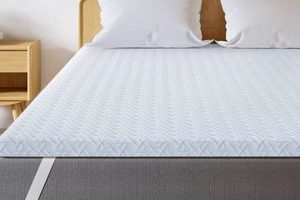
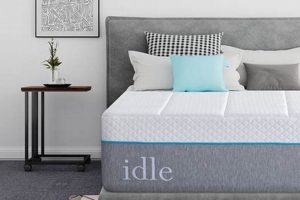
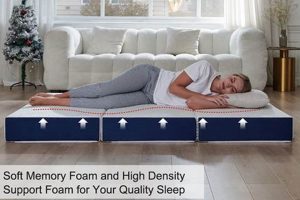
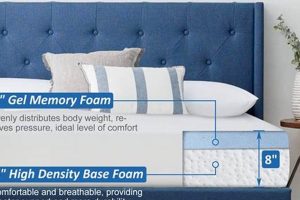
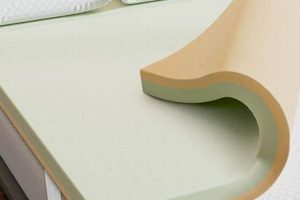
![Best Full Size 8 Inch Mattress For [Budget/Back Pain] Relief! Organic & Natural Mattress Buyer’s Guide: Non-Toxic Sleep Solutions Best Full Size 8 Inch Mattress For [Budget/Back Pain] Relief! | Organic & Natural Mattress Buyer’s Guide: Non-Toxic Sleep Solutions](https://mattressworldpa.com/wp-content/uploads/2025/07/th-3722-300x200.jpg)